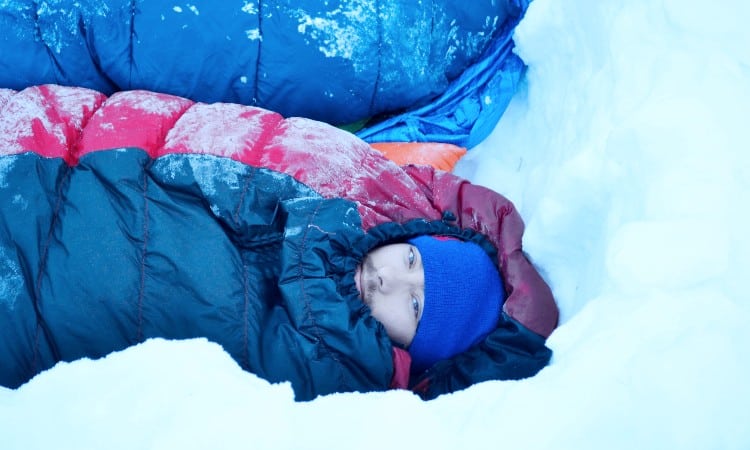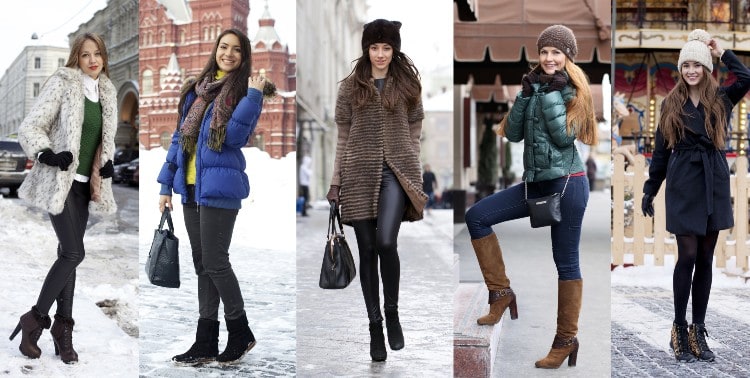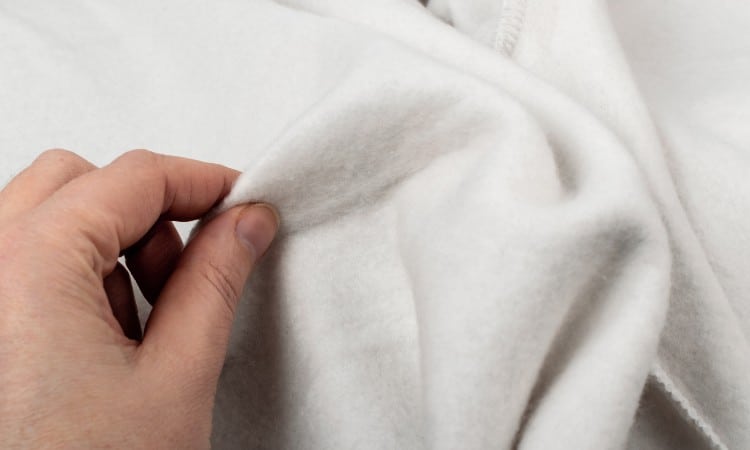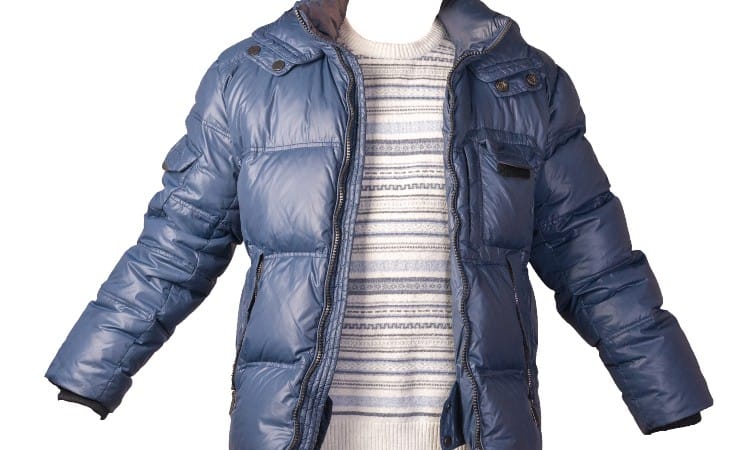Check the tag on the clothing you’re wearing. Chances are, the tag states that some percentage of the fabric is polyester. Polyester is basically plastic, making it very easy to cheaply mass produce. You will find polyester in many of the clothes you wear every day. But what about your winter clothes? Is polyester warm enough for winter?
Polyester can keep you warm and dry during winter. The weave and manufacturing process makes polyester an all-weather fabric. The choice between a thick multilayered single item or thin shell over other layers depends on outside conditions, level of activity, and how hot or cold you are normally.
Polyester is used to make a variety of fabrics and weaves, and is also blended with other natural and synthetic fibers. The properties of polyester and how it is manufactured determine its winter or summer use. In this article, we’ll explore the use of polyester in winter clothing and some outdoor equipment, and explain how polyester is one of the best materials for winter warmth.

How Warm is Polyester?
Polyester is great at holding in your natural body heat. This is because Polyester is made of very fine threads of plastic. The treads may be tightly woven together to keep the weather out, left as loose insulating fluff, or loosely woven to allow air and moisture through. Combining the different polyesters keeps the outside temperatures out and the warmth your body emits in. So, in short, polyester is as warm as your body makes it. But is that warm enough for winter?
Depending on where you live, how harsh your winters are, and how warm or cold you normally are, will greatly determine what you wear to keep warm. A polyester shell will do the trick if you live somewhere with mild winters.
A jacket with a tight woven rip-stop shell insulated with quilted polyester, and lined with polyester fleece might do if the temperatures don’t drop too far below 20 degrees Fahrenheit. Any colder than that, though, and you’re really going to want something heavier or possibly a polyester knit sweater layer underneath. If you don’t keep yourself warm enough, your immune system may be compromised, and your body becomes more likely to get sick.
Of course, personal preference comes into play as well. If you’re someone who’s always cold, you might want to opt for something heavier even in warmer winters. If you tend to be hotter, a polyester shell or fleece jacket might be perfect for you.
You also have to think about the wind chill. While polyester will keep you warm enough in 20°F weather, the wind might make it feel much colder than that, and you’ll want to grab something heavier to wear underneath.
Does Polyester Keep You Warm?

In general, polyester does a great job keeping you warm. As long as your body stays warm, polyester will trap that heat between you and the fabric. But if you stay toasty for too long, you may start to sweat. The same quality of polyester that keeps you warm, often lacks breathability, causing you to sweat.
Sweat is meant to cool you off, but being drenched in it isn’t the best way to stay warm. The type of polyester material determines its breathability. You want a moisture-wicking fabric closest to your body, such as a loosely woven polyester undershirt or long underwear to avoid this problem.
When covered with a cotton layer, the polyester is great at drawing the moisture away from your skin and into the cotton layer where it can evaporate. By itself, however, polyester may trap the sweat against your body.
Polyester is great in the snow as the tightly woven fabric is highly water-resistant. However, if only a thin layer of polyester fabric, having snow close to your body will make you cold. This is another reason why different layers of polyester materials work best – a tough weatherproof outer layer protecting warm polyester fill, and lined with polyester microfiber, Sherpa or fleece underneath.
Properties of Polyester
To begin with, polyester is a wrinkle, stretch, shrink, and sunlight resistant material. Here are some other properties of polyester:
- Fiber & Yarn – Fibers have a round cross-section and may be solid or hollow. Yarn is spun from threads or long fibers produced from a melt-spinning process into varying thicknesses for different cloths or fabrics.
- Water Resistant – Polyester is highly water resistant, dries very quickly, and is mildew resistant. Umbrellas are often made with polyester.
- Holds in Body Heat – Polyester can trap in the natural warmth of your body.
- Low Price – Polyester is one of the cheapest fabrics to purchase, so you won’t break the bank purchasing clothes made from this material.
- Windbreaker – Tightly woven polyester keeps the wind out. Many windbreaker jackets are made with polyester.
- Breathability – The weave of the fabric determines the airflow in polyester, so it can make you sweat or wick moisture away.
- Thickness – Polyester may be very thin fabric and lightweight like silk, or very thick Kevlar like material.
- Durable – Wet or dry, polyester is a strong, abrasion, and rip-resistant material.
When Can You Wear Polyester Clothes?
One reason polyester is such a commonly used fabric is its versatility. It can be worn year-round in all kinds of weather conditions, and also works well when paired with natural fabrics. Blended polyester fabrics or layering different fabrics make a great combination for any kind of weather and temperature.
Spring and Summer clothing is often made by blending polyester in combination with a more breathable fabric, like cotton. Polyester is an inexpensive fabric with few cons, so it is used quite often to manufacture clothes. Activewear often utilizes such a combination to keep athletes comfortable when working out.
Polyester complements any winter wardrobe too. Different weaves produce a variety of fabric weights, finishes, and breathability which will keep you cool in warm weather, and warm in cold temperatures. Whether hovering around freezing or an arctic blast of sub-zero temperatures, polyester has you covered. Selecting the material best for the weather and activity level may only be a matter of adding or shedding a layer.
Cold-Weather Clothing Made of Polyester

Most cold-weather clothing on the market today is made with at least some polyester. Some winter jackets have multiple layers of different polyester material – satin or fleece underlayer, polyester hollow-fill insulation, and a thick weatherproof outer shell. An alternative to a heavy jacket for cold-weather clothing is made of a few layers of different fabrics. You can do this yourself by layering different clothes.
- The base layer is the one touching your body. This layer should be moisture-wicking and breathable, so you don’t get swampy from sweat.
- The middle layer should be thicker, like an extra layer of skin to insulate and warm.
- The outer layer is to keep out the weather conditions (wind and snow).
The garment industry will typically incorporate all of these layers into their winter wear design, with some differences here and there. Winter boots feature a variation of the tough thick polyester outer layer, as they also need a waterproof rubber sole. Typically, winter hats and gloves are only one or two layers, but the heavier ones are made with three or more layers.
If you want the ability to put on and peel off layers as you need, you can layer different articles of clothing using this same system. Start with a light undershirt and wear a thick sweater over top of it.
Lastly, use a windbreaker jacket or a raincoat to keep out precipitation. If your boots aren’t warm enough, wear a thick pair of wool socks with them. Your body is your own, and only you can decide how warm you need to be comfortable.
Is Polyester Warmer Than Wool?

Wool is usually a much thicker fabric than polyester, so it will keep you warmer depending on the weave. Wool is often used as an insulator fabric in winter wear because of its warmth.
Wool provides excellent weatherproofing and warms even when wet, but dries slowly. Its major downside is its cost, often several times that of similar polyester products.
Depending on the current winter conditions in your area, you can forgo the polyester altogether and wear just wool. You can wear wool alone if it’s a cold day (20°F and below) regardless of wind or precipitation.
Is Polyester Warmer Than Cotton?
Cotton is often a light, breezy fabric used in clothing made for warmer temperatures. It is also the basis for thick denim or canvas fabrics too. If your winter wear options are polyester or cotton, choose polyester. It will keep you drier and warmer.
Cotton is perhaps the worst fabric for cold weather. Cotton, like wool, is less resistant to water, and dries more slowly. Wool, however, is far warmer when wet than cotton, so cotton isn’t the best pick for winter wear. It’s best to save your cotton clothing for when the weather warms up.
Polyester and Outdoor Equipment
If you’re outdoorsy even in the winter months, you might be curious about polyester when used in camping gear. For the most part, the layering concept applies here as well.
With tents, you don’t need a base layer to avoid sweat. Tents are made to keep you out of the elements, so a tent made purely of polyester is good at keeping you dry when it rains or snows.
Nylon is another popular choice for tent fabrics, but it is more lightweight, so less suitable than polyester for winter camping. Some tents are made specifically with winter camping in mind and feature an insulating layer. A better choice if you plan on camping during a harsh winter.
Sleeping bags, use the standard layering method. A breathable base layer, an insulating center, and polyester or nylon to weather the elements on the outside is the perfect recipe. Winter sleeping bags are made just like winter coats, usually featuring the same fabrics.
Camping backpacks frequently have one thick layer of polyester or nylon with stress-points and the bottom reinforced with a second layer. These fabrics are great for backpacks because of their durability, resistance to rips or tears, and their weatherproof properties.
It is worth noting that polyester and nylon aren’t 100% waterproof by themselves. As they are woven fabrics, there will be microscopic gaps in the weave. Most waterproof clothing and outdoor equipment are coated with PVC in order to seal off all the cracks and create a truly waterproof material.
Best Clothing Material for Winter

Winter wear comes in a variety of materials and mixtures of materials. Whether a single item with multiple layers or layering of multiple items, it is important to select the best fabric for each layer.
Let’s start with the base layer. Closest to your skin, you want the most breathable fabric. You don’t want to get sweaty, but if you do, you don’t want to stay wet. The best fabric for this purpose is usually a polyester blend.
Polyester blended with cotton creates a good mixture for a base layer. The cotton keeps you cool, but if you still sweat, the polyester will move it away from the skin so it can evaporate quickly.
Silk is another good option due to its thin threads. It’s super light and airy, so it’s a comfortable base layer at any season, but the polycotton blend fabric will be slightly warmer for the winter season.
For the central, insulating layer, you want a material that is going to insulate and keep you warm. Generally, the thicker the better for this layer. Top choices are polyester fills, loose wool, and down feathers. Down, in particular, is a great choice because the feathers create lots of open space between one another. The open spaces trap air and keeps it warm.
Wool does the same thing, but less effectively. Synthetic down or fill, typically made with polyester, is also very effective and dries more quickly than other insulation choices. Additionally, some of the warmest insulation is produced by blending down with synthetic fill, which is also referred to as down.
Synthetic may be your best bet if you want something hypoallergenic, though. This choice is largely up to your personal preference.
Lastly, the top layer should be of waterproof fabric. This is where polyester really performs. Nylon is another solid choice. Both of these fabrics are man-made, durable, and water-resistant. Again, it’s a personal preference that determines the best fabric choice for this layer as well.
If you’re looking for just one fabric to call the “best clothing material for winter”, then we’d have to go with polyester, but that’s only because it works so well with your body’s natural heating system.
Polyester isn’t the best clothing material for winter because it keeps you warmer than everything else or because you can wear polyester alone in the cold . It’s the best because there’s no single fabric that is better for this purpose. The true best clothing choice for winter is a combination of polycotton, down-blend, and polyester, layered in that order.
What is the Thinnest Warm Fabric?
Not a fan of bulky winter wear? Unfortunately, if you’re planning on going out in harsher winter conditions, it’s just not possible to stay warm with a form-fitting coat. Polyester is currently the closest mainstream winter wear has come to skin-tight cold-weather clothing.
In the future, you may be able to buy a winter coat insulated with aerogel. Aerogel is a super lightweight gel composed mostly of air. It’s a fantastic insulator, used in NASA spacesuits, but as you might expect, it’s incredibly expensive and difficult to work with, so it hasn’t blasted off in mainstream fashion. Maybe someday we’ll be able to get a fashion-forward winter coat, but for now, our options are limited.
Conclusion
Polyester is used to make silk-like liners and clothes, lightweight fiberfill, fleece, fluffy wool-like Sherpa lining, t-shirt material, tough durable outer shell fabrics, satins, and sheens. It may have a loose breathable weave or be so tightly woven it is basically water and weatherproof. A combination of the different manufacturing processes makes polyester ideal for winter wear and use.
What’s your go-to winter wear? If you enjoyed the article go ahead and share it, and let us know what you think in the comments below!